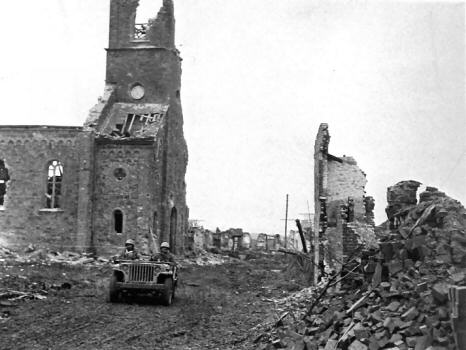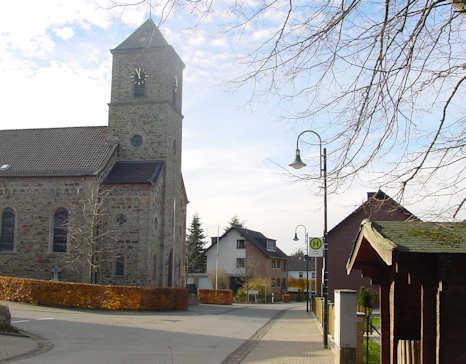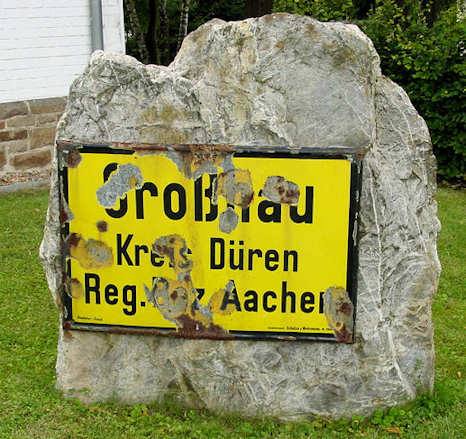(4TH INFANTRY DIVISION) IN THE HURTGEN FOREST,
GERMANY, 16 NOVEMBER - 3 DECEMBER 1944
(RHINELAND CAMPAIGN)
By Major Frederick T. Kent

THE ATTACK, 16 NOVEMBER - 3 DECEMBER cntnd.
On 29 November the 3rd Battalion was ordered to attack east through the woods north of GROSSHAU and seize the high ground northeast of the town. The 1st Battalion was to follow the 3rd and protect its flanks and rear. The 2nd Battalion was ordered to contain GROSSHAU and protect the right flank of the regiment south of the town. It was hoped that this would make the town untenable and force the enemy to surrender without the regiment making a costly frontal assault against the town itself. 19
Heavy artillery fire delayed the jump-off until 1200, an hour later than the scheduled time. The 3rd Battalion pushed relentlessly against very stubborn resistance and reached its objective by 1830, well after dark. 19
Just before noon the regimental commander received a direct order to take GROSSHAU that day. This order came originally from Corps and could not be modified. Against the better judgment battalions supported the attack by fire, but In spite of this support the company met bitter resistance. It fought until dusk, when a German counterattack supported by self-propelled guns hit the company and drove it back to its position of the night before. At the end of the day Co "C's" effective strength was 20 officers and men. This was not unusual in this operation. Companies frequently dug in for the night with only 20 to 40 men left, sometimes commanded by an enlisted man who had joined only a few days before. 19
The next day Co "B" attacked over the ground which Co "C" had taken and lost on the 26th. Under direct artillery fire and extremely heavy machine gun fire, 105 men attacked a well organized position on dominating ground. The company was stopped, and only by several examples of outstanding individual heroism was the enemy driven from his position. In this action Pfc Macario Garcia, ASN38246362, advanced alone after being wounded and knocked out two enemy machine gun crews. He received the Medal of Honor for this action. At 1230 the company, now reduced to 35 men, assaulted across a short stretch of open terrain and reached its objective. Co "E" pushed to the north and east and reached a position on the right of Co"B". Now armor could move along Road "B" unobserved, but the tank and tank destroyer units were reluctant to travel over a road which had not been swept for mines. After an infantry lieutenant from the Antitank Co drove a half-track over the road to prove that it was not mined, the armored vehicles moved forward. 19
On 28 November the 12th Infantry was assigned a zone of action on the left of the 22nd Infantry. The new boundary of the regimental commander, he ordered the 2nd Battalion to assault GROSSHAU from the west. This attack was launched at 1250, and at the same time a tank attack on the town from the south, was to start. The tanks almost immediately ran into a heavy mine field and two tanks were lost. A bog further restricted the movement of the tanks, but they continued seeking a route into GROSSHAU. An entry was finally found and the tanks contacted the 2nd Battalion foot troops in the western part of the town. Fierce fighting continued after dark and by 1915 GROSSHAU had fallen. Now the town was found to consist of buildings with reinforced concrete basements, equipped with steel doors and firing slits. Air bombardment and artillery fire had had little effect on these fortifications. Roads and trails taken during the day were cleared of mines, an antitank defense was set up with mines, antitank guns, tanks and tank destroyers, and supplies were delivered to the battalions. Enemy mortar and artillery fire was received during the night. 19

22nd Infantry in Grosshau

Grosshau today.
The 46th Armored Infantry Battalion was attached to the regiment to bolster its strength for subsequent attacks. 19
The plan of attack for 30 November was to use the 3rd and 2nd Battalions and the 46th Armored Battalion abreast, in that order from left to right, attacking to the northeast to capture and secure the edge of the woods south of GEY, a position from which a coordinated infantry-tank attack could be launched toward DÜREN. At first the 3rd Battalion met relatively little resistance, but as it approached its objective the resistance stiffened. The battalion was stopped and dug in for the night about 300 yards short of the edge of the woods.
The 2nd Battalion advanced slowly across the open terrain in its zone against heavy small arms, mortar, and artillery fire, gained a total of about 300 yards, and was stopped. In this attack the battalion moved around the high ground in its zone and crossed the corps boundary. 19
The 46th Armored Battalion, moving out to its line of departure, started receiving fire at 1020 from the high ground northeast of KIEINHAU. This ground had been reported the previous day as being held by Combat Command "R" of the 5th Armored Division, a report which was entirely false. Consequently, the 46th Battalion was forced to fight hard to reach its line of departure, and by the end of the day had reached the edge of the woods southeast of GROSSHAU, losing an estimated 50% of its fighting strength in the day's operation. The enemy was still offering determined resistance in his effort to keep us from breaking out of the forest. 19
The 1st Battalion moved forward in rear of the 3rd Battalion, organized a defensive position on the hill northeast of GROSSHAU, and covered the gap between the 2nd and 3rd Battalions. The enemy maintained continuous pressure on the 2nd Battalion. 19
On 1 December the 3rd Battalion was to continue its advance east to the edge of the woods. The 1st Battalion was to attack southeast, hitting the enemy facing the 2nd Battalion on its flank while the 2nd Battalion attacked by fire only. After reducing this enemy resistance, the 1st Battalion was to swing to the east and extend the 3rd Battalion line along the edge of the woods. The 2nd Battalion was to attack northeast. 19
The 3rd Battalion reached its objective at 1010 against moderate resistance. The 1st Battalion attacked behind a smoke screen, achieved a high degree of surprise, overran German machine gun positions and an artillery OP, and advanced through the woods to a point about 500 yards northeast of the 2nd Battalion. It then turned and attacked to the northeast, leaving one company behind to contact the 2nd Battalion. The 1st Battalion reached its objective by 1220 and tied in with the the 3rd Battalion. 19
In spite of the help furnished by the 1st Battalion, the 2nd Battalion met stiff resistance and progressed very slowly. In the late afternoon a strong counterattack hit Co "F", and the rest of the battalion was committed. Co "F" suffered severe casualties but the battalion line was finally secured at dusk. 19
The 46th Armored Battalion attacked on 1 December despite Its severe losses of the previous day, made very little progress, and at 1112 was directed to return to its jump-off position and hold there. The battalion was detached from the regiment at 2400. (19)
The regiment was once again very weak in fighting effectives. Casualties had mounted to 2304 enlisted men and 100 officers. Replacements received amounted to a total of 1699 enlisted and 35 officers. 19
On 2 December, elements of the 1st and 3rd Battalions were directed to attack south to clear the woods in front of the 2nd Battalion and assist its advance. Before the attack could be started, a strong German attack by a battalion of 250 fresh infantry troops hit Co "I" at 0650, broke through the line and headed for the high ground northeast of GROSSHAU. Co "K" moved south to seal off this penetration, and the 2nd Battalion was prepared to assist the 3rd. At 0740 the 3rd Battalion requested additional support, and a 60-man detachment from the Antitank Co which had been organized as a reserve and placed In GROSSHAU was moved forward. Another 80-man detachment, which had been organized from Headquarters and Service Companies the night before, moved to GROSSHAU to defend it and constitute the regimental reserve. CP's of the 1st and 3rd Battalions were attacked at 0815. Soon after that, enemy were reported on the high ground northeast of GROSSHAU. All available armor was assembled and directed to retake the hill. The penetration was sealed off, the enemy force was gradually mopped up, and the situation once again became stable on lines held the night before except for a slight withdrawal to more defensible terrain at the point of penetration by the enemy. 19
Information was received that the regiment would be relieved on 3 December by the 330th Infantry of the 83rd Infantry Division. Accordingly, positions were improved to attain the maximum defensive strength.
On 3 December the relief of the regiment began. It was retarded by an enemy attack against the 1st Battalion in the morning, an air attack by approximately 40 German fighter planes in the afternoon, and heavy artillery, mortar, and machine gun fire in the 2nd Battalion's area. Smoke was used to screen the movements, but even with this aid the relief could not be completed until after dark. 19
Responsibility for the area was turned over to the Commanding Officer, 330th Infantry, at 1900 and the 22nd Infantry moved to assembly areas approximately five miles west of the front lines preparatory to moving to Luxembourg the next day.
The 22nd Infantry Regiment had completed the most difficult task assigned to it during its combat operations in Europe and had made a substantial contribution to the success of the 1st US Army attack toward COLOGNE. However, the regiment had lost officers and men who could never be replaced. The total losses for the eighteen days of fighting in the Hurtgen Forest amounted to 2575 enlisted men and 103 officers. The losses in equipment were proportionately high, and the wear and tear on weapons and vehicles was the heaviest ever suffered in so short a period. 19

Although this monograph describes only the operations of the 22nd Infantry Regiment, the attached units which endured the same hardships and discomfort and fought the weather, the forest, the mud and the enemy with the regiment deserve the same recognition for their achievements as that received by the regiment, for without their aid the mission would have been far more difficult to accomplish. For its action in the Hurtgen Forest, which advanced our front lines 7500 yards to the open ground which formed the approaches to DÜREN, the regiment received a commendation from the division commander and the division was commended by the corps commander. The regiment later was cited for this action. 20

